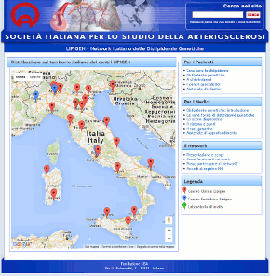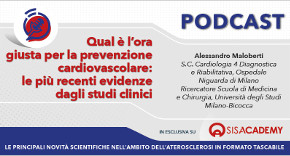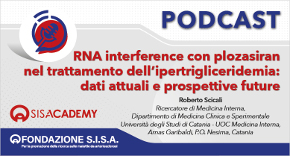 Rivista in lingua italiana
Rivista in lingua italiana
riservata ai Soci SISA
Ultimo numero:
Anno 16 • N.1/2025
SISANews
L'omocisteina può aiutare a stimare meglio il rischio cardiovascolare
L'omocisteina ha goduto di alterne fortune come indicatore utile per una stima più accurata del rischio cardiovascolare. Questo studio affronta ancora una volta il problema partendo dai dati di due noti studi: il Multi-Ethnic Study of Atherosclerosis (MESA) ed il NHANES III (National Health and Nutrition Examination Survey III) per un totale di 13.247 soggetti. L'aggiunta dell'omocisteina al pannello dei fattori di rischio dell'algoritmo di Framingham (età, sesso, fumo, diabete, pressione arteriosa, colesterolo totale e colesterolo HDL) ha condotto alla riclassificazione del rischio in circa il 20% dei casi con un miglioramento significativo della capacità previsionale di eventi cardiaci, soprattutto nelle classi di rischio intermedio. In altri termini, omocisteina elevata significa rischio cardiovascolare ben più alto di quanto desumibile dall'algoritmo di Framingham.
![]()
Homocysteine and Reclassification of Cardiovascular Disease Risk
Veeranna V, Zalawadiya SK, Niraj A, Pradhan J, Ference B, Burack RC, Jacob S, Afonso L.
J Am Coll Cardiol 2011;58:1025-1033
OBJECTIVES: The purpose of this study was to examine whether adding homocysteine (Hcy) to a model based on traditional cardiovascular disease (CVD) risk factors improves risk classification.
BACKGROUND: Data on using Hcy to reclassify individuals in various risk categories beyond traditional approaches have not been adequately scrutinized.
METHODS: We performed a post hoc analysis of the MESA (Multi-Ethnic Study of Atherosclerosis) and NHANES III (National Health and Nutrition Examination Survey III) datasets. Hcy was used to predict composite CVD and hard coronary heart disease (CHD) events in the MESA study and CVD and CHD mortality in the NHANES III survey using adjusted Cox-proportional hazard analysis. Reclassification of CHD events was performed using a net reclassification improvement (NRI) index with a Framingham risk score (FRS) model with and without Hcy.
RESULTS: Hcy level (>15 µmol/l) significantly predicted CVD (adjusted hazard ratio [aHR]: 1.79, 95% confidence intervals [CI]: 1.19 to 1.95; p = 0.006) and CHD events (aHR: 2.22, 95% CI: 1.20 to 4.09; p = 0.01) in the MESA trial and CVD (aHR: 2.72, 95% CI: 2.01 to 3.68; p < 0.001) and CHD mortality (aHR: 2.61, 95% CI: 1.83 to 3.73; p < 0.001) in the NHANES III, after adjustments for traditional risk factors and C-reactive protein. The level of Hcy, when added to FRS, significantly reclassified 12.9% and 18.3% of the overall and 21.2% and 19.2% of the intermediate-risk population from the MESA and NHANES cohorts, respectively. The categoryless NRI also showed significant reclassification in both MESA (NRI: 0.35, 95% CI: 0.17 to 0.53; p < 0.001) and NHANES III (NRI: 0.57, 95% CI: 0.43 to 0.71; p < 0.001) datasets.
CONCLUSIONS: From these 2 disparate population cohorts, we found that addition of Hcy level to FRS significantly improved risk prediction, especially in individuals at intermediate risk for CHD events.
J Am Coll Cardiol 2011;58:1025-1033

Area Soci
Eventi
39° Congresso Nazionale
 39° Congresso Nazionale
39° Congresso NazionaleRoma, 23-25 novembre 2025
Save the date




 Spring Meeting Gruppi Giovani SID, SIGG, SIIA, SIMI, SIPREC, SISA
Spring Meeting Gruppi Giovani SID, SIGG, SIIA, SIMI, SIPREC, SISARimini, 6-8 aprile 2025
[continua a leggere]
 SISA LIPID ACADEMY - Corso avanzato di lipidologia clinica
SISA LIPID ACADEMY - Corso avanzato di lipidologia clinicaModena, 4-5 Luglio 2024
[continua a leggere]Giornale Italiano Arteriosclerosi
HoFH today
 Rivista Italiana della
Rivista Italiana della
Ipercolesterolemia
Familiare Omozigote
Anno 6 • N.1/2024
Rivista NMCD
Diateca
[continua a leggere]
[continua a leggere]
Newsletter
il vostro indirizzo di posta elettronica
Progetto LIPIGEN

Nuovo sito dedicato al Progetto LIPIGEN
Progetto LIPIGEN - Vecchio portale
E' necessario essere loggati come utente
Lipigen per poter accedere alla pagina
PROject Statin Intolerance SISA
PROSISA – PROject Statin Intolerance SISA
E' necessario essere loggati come utente
PROSISA per poter accedere alla pagina
GILA - Lipoprotein Aferesi
Gruppo Interdisciplinare Lipoprotein Aferesi
(Accesso Gruppo GILA-Lipoprotein Aferesi)
E' necessario essere loggati come utente del Gruppo GILA per poter accedere
Gruppo Interdisciplinare Lipoprotein Aferesi
(Documentazione ad accesso libero)
Pagina informativa per medici e pazienti










